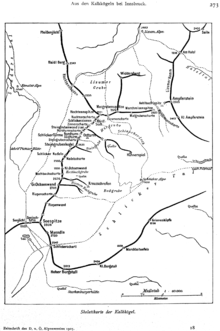Kalkkögel
| Kalkkögel | ||
|---|---|---|
|
The Kalkkögel from the northwest, at the Schönangerlsee on the Salfeins |
||
| Highest peak | Schlicker Seespitze ( 2804 m above sea level ) | |
| location | Tyrol , Austria | |
| part of | Stubai Alps | |
|
|
||
| Coordinates | 47 ° 9 ' N , 11 ° 16' E | |
| rock | dolomite | |
| Age of the rock | Triad | |
The Kalkkögel are a mountain range that belongs to the Stubai Alps in Tyrol , Austria . The highest point of the Kalkkögel is the Schlicker Seespitze with 2804 m above sea level. A .; the easternmost mountain is the Ampferstein .
geology
The Kalkkögel consist of Mesozoic sediments , such as those found elsewhere west of the Wipptal in the Stubai Alps, for example in the Serleskamm or in the area of the Tribulaune. In the Kalkkögel area, there are sediments from the time from the Permian - Triassic border up to the Norium of the Upper Triassic, which rest on the crystalline base. For the most part, however, these sediments consist of Dolomites of the Middle and Upper Triassic. These dolomites are separated into a lower and an upper dolomite by a ten-meter-thick band of slightly metamorphic slate , the so-called Raibler layers . Even if this band is only thin, it creates a clear morphological structure. At the base of the Mesozoic sediments there is a sequence of conglomerate and sandstone . In this layer, which is a maximum of a few tens of meters thick, there are iron ore deposits , the most important of which was mined south of the Burgstall and formed the basis of the tool industry that still exists today in the Stubai Valley . In terms of external appearance, the Kalkkögel resemble the Dolomites , which is why they are often referred to as the "North Tyrolean Dolomites".
Overview of the individual peaks
- Saile
- Ampferstein
- Marchreisenspitze
- Malgrubenspitze
- Hochtennspitze
- Stone pit wall and Schlicker Zinnen
- Steingrubenkogel
- Small ox wall
- Big ox wall
- Riepenwand
- Schlicker Seespitze
- Ariesberg
- Tailor
- High castle stable
- Lower Burgstall
Development and conservation
The Kalkkögel are a hiking and climbing area and, with the Schlick on the south flank, have a ski area that is accessible from Fulpmes , and one in the north, the Axamer Lizum , which only leads into the inntal side chains of the Kalkkögel ( Salfainskamm , Saile ). The Kalkkögel can also be reached from Grinzens via the Kemater Alm and the Adolf-Pichler-Hütte . Further bases are the Starkenburger Hütte via Neustift and the Birgitzköpflhütte , which can be reached from the Lizum and the Mutterer Alm via lifts.
In 1983 the Kalkkögel quiet area was established, which covers almost all of the Kalkkögel and the surrounding area with 77.7 km². In Tyrolean nature conservation law, quiet areas are a tool to put areas less under general nature protection and more under a construction freeze: There are plans to merge the Schlick 2000 and Axamer Lizum ski areas , which the Austrian Alpine Association and various other groups see as a threat to the quiet area. From 1956 to 1983 there was a nature reserve in the Mutterer Alpe sub- area .
Web links
- Geology of the Kalkkögel. (No longer available online.) In: Senderswind. September 11, 2007, archived from the original ; accessed on May 31, 2017 .
literature
- Walter Klier: Alpine Club Guide Stubai Alps Alpine . 13th edition. Bergverlag Rudolf Rother, Munich 2006, ISBN 3-7633-1271-4 .
Individual evidence
- ↑ Fridolin Purtscheller, Ötztaler and Stubai Alps , Geological Guide Collection, Volume 53, 2nd edition, Verlag Gebrüder Borntraeger, Berlin-Stuttgart 1978, ISBN 3-443-15022-5 , pp. 30–32.
- ↑ Reinhard Exel: Die Mineralien Tirols , Volume 2. Nordtirol, Vorarlberg and Osttirol, Verlag Athesia, Bozen / Vienna 1982, ISBN 88-7014-261-2 , p. 143f.
- ↑ Complete edition : Journal of the German Alpine Association / Journal of the German and (the) Austrian Alpine Association , year 1903, p. 301 (online at ANNO ).
- ↑ Kalkkögel quiet area. In: RIS: State law consolidates Tyrol. Federal Chancellery, accessed on January 7, 2018 .
- ↑ Kalkkögel. In: tiroler-schutzgebiete.at. State of Tyrol, Environmental Protection Department, accessed on March 16, 2016 .
- ^ Advertise for the Schlick - Lizum merger. In: tirol.orf.at. February 28, 2009, accessed August 18, 2010 .
- ↑ Against the exploitation and destruction of our natural area Kalkkögel. In: Unserkalkkoegel.at. Retrieved August 18, 2010 .
- ↑ OeAV: Development stop for protected areas - oesterreich.ORF.at. In: tirol.orf.at. December 21, 2009, accessed August 18, 2010 .
- ^ Ordinance of the state government of September 7, 1956 on the declaration of the area of the Mutterer Alpe in the municipalities of Mutters, Götzens, Birgitz and Axams as a nature reserve. : Landesgesetze für Tirol , born 1956, p. 77 (online at ANNO ).




